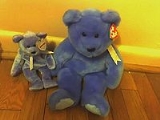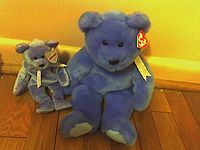
Clubby
Encyclopedia
Clubby was a Beanie Baby
that was available in 1998 exclusively by mail order
to those who joined the Beanie Babies Official Club by purchasing a kit. It was followed up in later years by other bears also named "Clubby" followed by a roman numeral. In all, a total of ten styles of bears
, named Clubby, Clubby II, Clubby III, Clubby IV, Clubby V, Clubby VI (three versions - rainbow colored teddy bear, blue potbelly style bear, and matching purple potbelly style bear), Clubby VII and Clubby VIII. In addition, Beanie Buddies of Clubby I, Clubby II, Clubby III, Clubby IV, Clubby V, and Clubby VI (rainbow version) were produced. Although the Clubby bears were not rare, they often proved elusive for people who weren't enrolled in the club, who were forced to search for them on the secondary market
or through the Ty Store.
issued a $216,000 fine against the company.
 Clubby II came out in 1999. In order to settle complaints from customers during the previous year about delayed shipments, Clubby II was sold within the kit that was found in stores for about $20, which also included a coin, a checklist, a set of Ty trading cards, and other Beanie items. In another CYRK blunder, the "carrying case" for the kit (which was designed to double as a Beanie Baby display case) was made entirely out of PVC, which is known to damage fabric over time.
Clubby II came out in 1999. In order to settle complaints from customers during the previous year about delayed shipments, Clubby II was sold within the kit that was found in stores for about $20, which also included a coin, a checklist, a set of Ty trading cards, and other Beanie items. In another CYRK blunder, the "carrying case" for the kit (which was designed to double as a Beanie Baby display case) was made entirely out of PVC, which is known to damage fabric over time.
Beanie Baby
A Beanie Baby is a stuffed animal, made by Ty Warner Inc., which was later renamed as Ty Inc. in late 1993. Each toy has an inner "posable lining" and is stuffed with plastic pellets rather than conventional stuffing , giving Beanie Babies a flexible feel.The original nine Beanie Babies launched...
that was available in 1998 exclusively by mail order
Mail order
Mail order is a term which describes the buying of goods or services by mail delivery. The buyer places an order for the desired products with the merchant through some remote method such as through a telephone call or web site. Then, the products are delivered to the customer...
to those who joined the Beanie Babies Official Club by purchasing a kit. It was followed up in later years by other bears also named "Clubby" followed by a roman numeral. In all, a total of ten styles of bears
Teddy bear
The teddy bear is a stuffed toy bear. They are usually stuffed with soft, white cotton and have smooth and soft fur. It is an enduring form of a stuffed animal in many countries, often serving the purpose of entertaining children. In recent times, some teddy bears have become collector's items...
, named Clubby, Clubby II, Clubby III, Clubby IV, Clubby V, Clubby VI (three versions - rainbow colored teddy bear, blue potbelly style bear, and matching purple potbelly style bear), Clubby VII and Clubby VIII. In addition, Beanie Buddies of Clubby I, Clubby II, Clubby III, Clubby IV, Clubby V, and Clubby VI (rainbow version) were produced. Although the Clubby bears were not rare, they often proved elusive for people who weren't enrolled in the club, who were forced to search for them on the secondary market
Secondary market
The page applies to the finanical term; For the merchandising concept, see Aftermarket .The secondary market, also called aftermarket, is the financial market where previously issued securities and financial instruments such as stock, bonds, options, and futures are bought and sold....
or through the Ty Store.
Clubby
The first of the series, Clubby I, simply known as Clubby, came out in 1998. The bear could be obtained through the purchase of a BBOC kit for about $5, followed by mailing in a membership application form, along with about $10 for the cost of the bear itself plus shipping. While the offer was made, there was a heavy demand for the collectible, and many orders came long past when they were promised as the volume overwhelmed production and fulfillment capabilities, leading many consumers to grow frustrated and become disenchanted with the club. http://www.accessmylibrary.com/coms2/summary_0286-27482056_ITM CYRK, Inc. (NASDAQ:CYRK) Exclusive Licensee and principal marketer of The Official Beanie Baby Club and the iconic "Clubby" Beanie Baby was charged with failing to timely deliver; The Company acknowledged the supply chain challenges and agreed to pay $216,000 civil penalty for violating FTC Mail Order Rule. | M2 Presswire (Februa...]. The Federal Trade CommissionFederal Trade Commission
The Federal Trade Commission is an independent agency of the United States government, established in 1914 by the Federal Trade Commission Act...
issued a $216,000 fine against the company.
Clubby II


